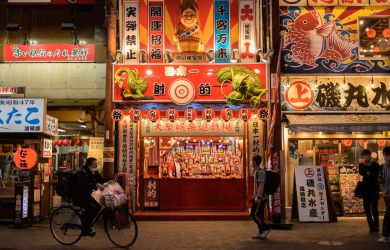
November 5, 2009
Ladies First
A pair of former OL’s roll up their sleeves to create a thriving real estate niche
By Metropolis
Originally published on metropolis.co.jp on November 2009

Kana Arai (left) and Kumi Tahara get to work
Photos by Kohji Shiiki
Kana Arai and Kumi Tahara offer a service that women adore and men can only fantasize about. Their real estate agency, Tokyo Girls Fudosan (TKGF), provides stylish female-only apartments at affordable rents in some of the city’s trendiest neighborhoods. In an urban environment where most young people settle for boxy one-room apato, TKGF’s accommodations offer the added attractions of space and community. And they’ve ignited a trend—since starting with just a single unit four years ago, the company now operates ten residences throughout the city, and a host of agencies offering similar services have followed in its wake.

The emergence of an entirely new niche in Japan’s hidebound real estate industry is surprising, but the most notable thing about TKGF turns out to be the two women behind its success. Arai and Tahara are not, as one might assume, members of Tokyo’s old-boy realty network, nor are they MBA-wielding hotshots backed by an army of investors. Instead, the city’s hippest realtors are a pair of former OL’s who have built their business with little more than pluck, talent—and a serious aversion to Ikea furniture.
In an interview at an appealingly dowdy café near their office in upscale Minami-Aoyama, Tahara and Arai admit that they are unlikely candidates for entrepreneurial success. Tahara, 27, is a former JAL check-in girl who considered giving up her career for the happy-go-lucky life of a grad student. Arai, 32, says she spent so little time studying at Gakushuin Women’s Junior College that she may as well have received a degree in partying. The pair, who met while working in sales for a large real estate agency, say they originally saw each other as rivals. Their business plan was hatched after ditching work one day to enjoy afternoon tea in the lobby lounge of the Ritz-Carlton, Tokyo.
Though their backgrounds are decidedly nontraditional, the two women are remarkably well suited to their roles. Tahara’s training in customer service complements Arai’s decade-long experience in real estate. Both are skilled artisans who do most of their own design work and renovations. And they know how to play the media—not only are Arai and Tahara agreeably photogenic, they require all residents to make themselves available for interviews as a condition of their lease.
TKGF’s business model bucks industry norms by doing away with key money and most other deposits; residents can also move laterally among the agency’s properties. A typical TKGF apartment consists of private bedrooms that link to common areas, kitchens and bathrooms. The smallest unit accommodates four residents; the largest, ten. Rents range from ¥52,000 to ¥125,000. The formula has proved irresistible—TKGF’s 400 rooms are in constant demand, with a waiting list numbering in the dozens.
All this comes at a time when other Tokyo realtors are struggling with a tanking market and empty buildings. According to economic trends researcher Teikoku Databank, 479 real estate companies around the country went bankrupt last year, including 75 that specialized in apartments. Occupancy rates for many major companies, which as recently as last November stood at around 95 percent, have plunged below 90 percent.
In fact, it was the downturn in the local real estate industry that provided TKGF with its opening.
“A landlord we knew was having trouble with unoccupied apartments in his building, and as an experiment, we helped him turn the rooms into a share house,” Arai says. “It turned out to be a big success. The owner introduced us to others, and they introduced us to more people, and—well, here we are.”
TKGF’s business took off in earnest in the wake of last year’s global banking crisis, which resulted in an exodus of highly paid foreigners from Tokyo. Suddenly, the market was flooded with luxury apartments that lacked tenants—and little chance of attracting any among the locals.
“Japanese people usually aren’t interested in those kinds of places, so many building owners found themselves with this problem on their hands,” says Tahara. “We help them out by suggesting to do a share house.”







